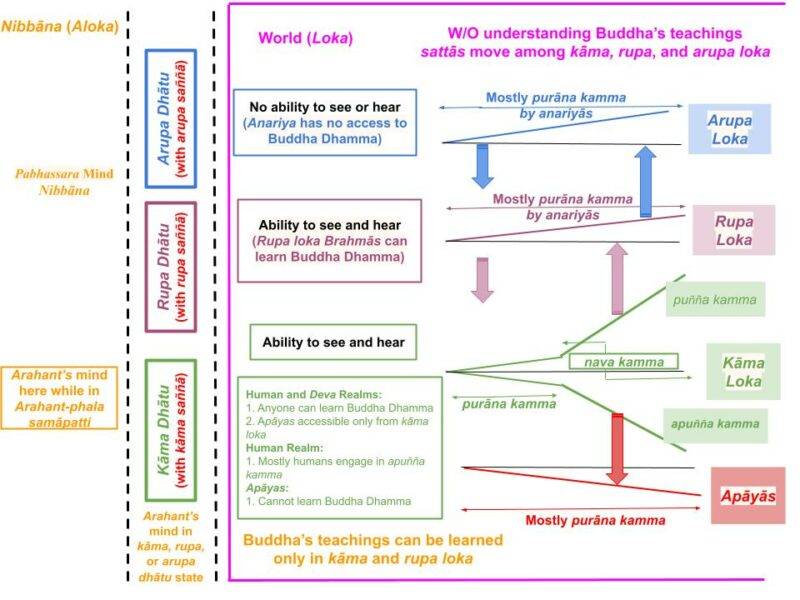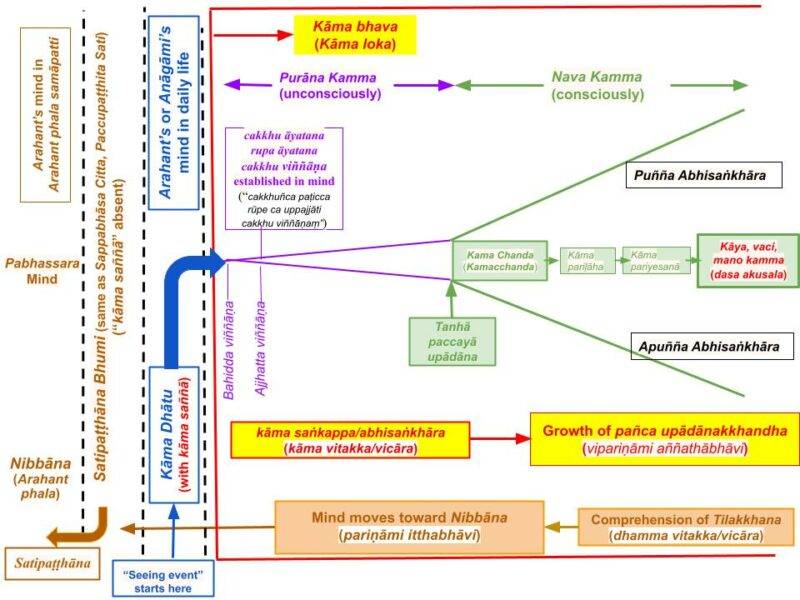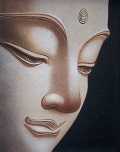Sotapanna stage is reached by removing sakkāya diṭṭhi, the wrong view that only “sensory pleasures” can overcome suffering. To do that, one must learn Buddha’s worldview from a disciple of the Buddha.
February 23, 2025

Download/Print: “Loka and Aloka – Totally Separated“
The Broad Overview
1. A simple representation of the world and Nibbāna (removed from the world) is shown in the above chart. Let us discuss the necessary features. Of course, one must get rid of uccheda and sassata diṭṭhi first, as discussed in the previous post, “Path to Nibbāna – The Necessary Background.”
- One must learn Buddha’s teachings from a Buddha or a disciple who has attained a magga phala, i.e., at least the Sotapanna stage. We have two sense faculties used for learning: listening and reading. Either or both can be used.
- Both those sense faculties are absent in arupa loka (those Brahmās have only the mind). Thus, unless they had attained at least the Sotapanna stage in a previous life, they cannot learn anything about Buddha’s teachings.
- Those in the four lowest realms (apāyās) also cannot learn Buddha Dhamma because their minds don’t generate “ñāna sampayutta citta” per Abhidhamma, i.e., they don’t have the wisdom to grasp the teachings.
- Therefore, only those in the human, Deva, and rupa loka realms can learn Buddha Dhamma and attain a magga phala.
- A given sattā (any living being with no magga phala; a “puthujjana” if in the human realm) moves up and down among the realms endlessly (most time spent in the apāyās) until grasping Buddha Dhamma and attaining Nibbāna.
- Suffering does not end until one is fully separated from the world (on the right side) and moves to the left-most region. That happens for the first time at the Arahant-phala moment. Then, until the death of the physical body, Arahant‘s mind is mostly in the middle region; see below. Until the death of the physical body of an Arahant, a mind must be in one of the three regions in the above chart; at the death of the physical body of an Arahant, the mind will disappear from the chart; that is the end of suffering.
A Mind Must be in One of the Three Regions
2. Attaining the highest magga phala (Arahanthood) means separation from the world of 31 realms in the three lokās: kāma, rupa, and arupa loka. See “Loka and Nibbāna (Aloka) – Complete Overview.”
- However, an Arahant must live in this world until the physical body’s death. Upon death, he/she will not be reborn in any of the 31 realms within the three lokās.
- Yet, the mind of a living Arahant will never get inside the “world boundary” marked by the “pink box” in the above chart. (Any mind anywhere within the “pink box” or the “world” inevitably generates thoughts of rāga, dosa, or at least moha.)
- Until death, the mind of an Arahant stays in one of three “dhātu” states (“here, dhātu means the “landing state” for any thought). During normal daily life it is the “kāma dhātu” for an Arahant born in kāma loka. If the Arahant can get into a jhāna (mindset of rupa loka Brahmās), their minds will be in rupa dhātu. If the Arahant can get into an arupa samāpatti (the mindset of arupa loka Brahmās), their minds will be in arupa dhātu.
- The mind of a sattā also lands first in a dhātu stage (for example, the mind of a puthujjana lands in “kāma dhātu” and that of an anariya rupa loka Brhama lands in the “kāma dhātu“), but immediately transitions to inside of the “pink box” or the “world.” Thus, a sattā‘s mind will ALWAYS be inside the “pink box.”
Difference Between the Two Regions on the Left in the Chart
3. As we have discussed, any mind in a dhātu stage would have the corresponding “distorted saññā“: “kāma saññā” in kāma loka, “rupa (jhāna) saññā” in rupa loka, and “arupa (samāpatti) saññā” in arupa loka. A puthujjana‘s (or a sattā‘s) mind will also start at a dhātu stage but immediately move to the “purāna kamma” state in one of the three lokās.
- Some Arahants can experience thoughts free of even the “distorted saññā” by getting into “Arahant-phala samāpatti.” Here, their cittās would not have the distorted saññā associated with any loka/realm; they will only be aware that they are still living and will not experience any sense event.
- Thus, any given mind must be in one of the three regions separated by the dotted lines. A puthujjana‘s mind is ALWAYS in the right region (“pink box”), and an Arahant‘s mind could be in one of the other two regions on the left.
A Sattā Moves Among the Three Lokas Endlessly
4. Therefore, until a Buddha shows how to separate from the world delineated by the “pink box,” a sattā (without magga phala) is trapped in the endless rebirth process.
- The “nava kamma” stage is where a human puthujjana accumulates kammic energies for future rebirths. The high upward-sloping line indicates the accumulation of “good kamma,” and the downward-sloping line suggests the accumulation of “bad kamma.“
- By cultivating puñña kamma, a human can move up to the Deva realms above. By cultivating jhāna/arupa samāpatti, they can move up to Brahma realms. (That is the most ancient yogis (like Alara Kalama and Uddaka Ramaputta) could do. The discovery of the “purāna kamma” stage by our Bodhisatta led to his Enlightenment.)
- On the other hand, by cultivating apuñña kamma, they will move down to the apāyās. The bad news is that a sattā spends most of the rebirth process in the apāyās.
- The truth of that statement can be seen by comparing the population in the human realm with that in the only apāya we can see, the animal realm. We have only about eight billion humans on Earth, but many animal species have trillions in each realm!
- See, for example, “How the Buddha Described the Chance of Rebirth in the Human Realm.”
Abstaining from Dasa Akusala Is Not Enough to Attain Nibbāna
5. Most people believe abstaining from immoral deeds is enough to avoid future suffering.
- Some say, “I don’t hurt anyone or do immoral things, so I should be fine. What is the need to do things like striving for Nibbāna?”
- They don’t understand the power of temptations. If the sansāric bonds (saṁyojana) remain intact, anyone could be tempted to do immoral deeds under tempting conditions. We have heard many “highly moral people” getting caught engaging in immoral deeds. If the temptation is strong enough, the mind of any puthujjana is capable of the worst crimes. Angulimala was an intelligent student until turning into a monster, killing almost a thousand people. Ven. Moggalana, in a relatively recent previous life, had killed his two parents! There are many such accounts in the Tipiṭaka.
- The first step in understanding that forceful abstaining from dasa akusala in not enough to reach Nibbāna is to understand the following chart.

Download/Print: “Path to Sotapanna from Kama Loka“
6. Before a Buddha comes to the world, no one can know of the “purāna kamma” state in the above chart. Morality is defined ONLY by whether one engages in puñña or apuñña kamma (in the “nava kamma” stage).
- Ancient yogis knew that engaging in apuñña (immoral) kamma led to rebirths in lower realms. They also knew that engaging in puñña (moral) deeds could bring rebirths in the Deva realms. Some (like Alara Kalama and Uddaka Ramaputta) also knew that giving up sensual pleasures (kāma rāga) allows one to cultivate jhāna and have a rebirth in a Brahma realm.
- However, they did not know that attachment to any of the three lokās occurs well before a mind gets to engaging in puñña/apuñña kamma.
- The “bondage” to the world occurs at the “purāna kamma” stage, at the moment of experiencing a sensory event; one is not even aware that one has already attached. That is why details of this “purāna kamma” stage are essential to understand to become a sandiṭṭhiko (one who has “seen the Dhamma.”) See “Sandiṭṭhiko – What Does It Mean?.”
Any Sense Event Takes a Mind Away from Nibbāna
7. Any sense event takes the mind of a sattā (whose ten saṁyojana remain intact) away from Nibbāna, as seen in the above second chart. The mind of a a sattā ALWAYS transitions into the RIGHT to be inside the “loka/world” and AWAY from Nibbāna. Thus, without that understanding, a sattā cannot attain Nibbāna (which requires separating from the world).
- Attachment to the world (a mind moving to right in the chart) happens with every sense event. Most sensory events do not reach the “nava kamma” stage, where kammic energies that can bring rebirths are generated. Even if the mind does not get to the “nava kamma” stage, the mind is already attached to the world in the “purāna kamma” stage.
- We have discussed the sequence of “attachment events” in many posts, but I have further clarified it in the second chart above. For anyone born in kāma loka, any sensory event starts at the “kāma dhātu” stage.
- The mind of a puthujjana in the human realm will immediately transition to the kāma loka/bhava. For an Arahant (or an Anāgāmi who has removed the lower five saṁyojana, including kāma rāga), the mind will stay in the “kāma dhātu” stage.
Key Steps in Mind Contamination Inside the “World”
8. Once in the kāma loka, a mind will rapidly become contaminated in many steps (see “Purāna and Nava Kamma – Sequence of Kamma Generation” and “Ārammaṇa (Sensory Input) Initiates Critical Processes“). Only the key steps are shown in the above second chart. A mind will go through the “purāna kamma” stage unconsciously, i.e., a puthujjana has no idea of these steps or that one has started experiencing a sense event. Only after the “taṇhā paccayā upādāna” step in Paṭicca Samuppāda that a mind starts generating javana citta that can generate kammic energies for future rebirths.
- Before the description of the “purāna kamma” stage by a Buddha, humans could only try to deal with the “nava kamma” stage, as discussed above.
- While those efforts can lead to rebirths in the “good realms” (human, Deva, and Brahma), they can NEVER end suffering. That is because once passing the “purāna kamma” stage, a mind would have already started moving away from Nibbāna; see the above charts.
- That is why it is essential to understand how a mind transitions from the “kāma dhātu” stage to the “purāna kamma” stage. That is the “previously unheard teachings of a Buddha”!
Four Conditions to Attain the Sotapanna Stage
9. From the above discussion, we can understand why four conditions (sotāpatti aṅga) must be satisfied for a puthujjana to reach the Sotapanna stage. Those conditions are stated in many suttas but are in the short “Aṅga Sutta (sn 55.50)“: “Sappurisasaṁsevo, saddhammassavanaṁ, yonisomanasikāro, dhammānudhammappaṭipatti.”
- That worldview can be learned only from a sappurisa/Ariya (a Noble Person) who has understood it.
- In the days of the Budhha, a puthujjana could learn it only by hearing it since written texts were unavailable. Thus, the second condition of saddhamma savana is to listen to such a person. However, that worldview can be learned these days by reading lengthy explanations such as these posts. Also, see #5 of “Four Conditions for Attaining Sōtapanna Magga/Phala.”
- Once explained, a puthujjana with sufficient wisdom and necessary background (“Path to Nibbāna – The Necessary Background“) can fulfill the thrid condition of yoniso manasikāra. The translation in that in the link is “rational application of mind.” However, yoniso manasikāra requires understanding Paṭicca Samuppāda. See “Yoniso Manasikāra and Paṭicca Samuppāda.”
- The fourth condition of dhammānudhamma paṭipatti mainly requires contemplating those concepts learned from the sappurisa. The Sotapatti phala may be realized while listening/reading or contemplating what one learned. Again, see #5 of “Four Conditions for Attaining Sōtapanna Magga/Phala” for examples from the Tipiṭaka. This is also why it is incorrect to say that a Sotapatti phala moment must happen while listening to a discourse.
Diṭṭhi, Taṇhā, Māna – All Arise Due to “Distorted Saññā“
10. Three types (diṭṭhi, taṇhā, māna) of sansāric bonds must be broken to attain Arahanthood or full Nibbāna:
- Three types of “diṭṭhi-related saṁyojana“: sakkāya diṭṭhi, vicikicchā, silabbata parāmāsa (removed at the Sotapanna stage.)
- Four types of “taṇhā-related saṁyojana“: kāma rāga, paṭigha, rupa rāga, arupa rāga (removed at the Anāgāmi and Arahant stages.)
- Three types of “māna-related saṁyojana“: māna, uddhacca, avijjā (removed at the Arahant stage.)
- In a future post, we will discuss how all three types have their origin in “distorted saññā” as pointed out in the highly condensed “Mūlapariyāya Sutta – The Root of All Things.”
